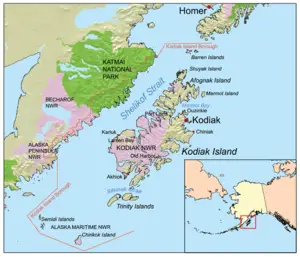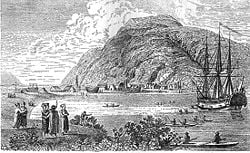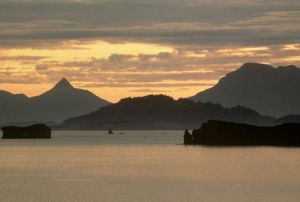Difference between revisions of "Kodiak Island" - New World Encyclopedia
Mary Anglin (talk | contribs) |
Mary Anglin (talk | contribs) |
||
| Line 82: | Line 82: | ||
The [[Kodiak Island Borough, Alaska|Kodiak Island Burough]] contains all of the Kodiak Archipelago and some lands on the mainland. The [[Kodiak National Wildlife Refuge]] encompasses a large percentage of the land in the archipelago. | The [[Kodiak Island Borough, Alaska|Kodiak Island Burough]] contains all of the Kodiak Archipelago and some lands on the mainland. The [[Kodiak National Wildlife Refuge]] encompasses a large percentage of the land in the archipelago. | ||
| − | |||
| − | |||
| − | |||
| − | |||
| − | |||
| − | |||
| − | |||
| − | |||
| − | |||
| − | |||
| − | |||
| − | |||
| − | |||
Revision as of 06:24, 1 June 2008

| |
| Geography | |
|---|---|
| Location | Pacific Ocean |
| Coordinates | Coordinates: |
| Archipelago | Kodiak Archipelago |
| Area | 8,975 km² (3,465 sq mi) |
| Country | |
| State | Alaska |
| Borough | Kodiak Island |
| Largest city | Kodiak |
| Demographics | |
| Ethnic groups | Alutiiq |
Kodiak Island is a large island on the south coast of the U.S. state of Alaska, separated from the Alaska mainland by the Shelikof Strait. It is the largest island in the Kodiak Archipelago and at 8975 km² (3465 squares mile) in area is the largest island in Alaska and the second-largest island in the United States (after the Big Island of Hawaii). It is 160 km (100 miles) long and in width ranges from 16 to 96 km (10 to 60 miles).
Kodiak Island is mountainous and heavily forested in the north and east, but fairly treeless on the south. The island has many ice-free, deep bays that provide sheltered anchorages for boats. The southwestern two-thirds of the island, like much of the Kodiak Archipelago, is part of Kodiak National Wildlife Refuge.
Kodiak Island is part of the Kodiak Island Borough of Alaska. The largest town on the island is Kodiak. Other settlements include the villages of Akhiok, Old Harbor, Karluk, Larsen Bay, Port Lions, and Ouzinki. Kodiak is also home to a large Coast Guard station, Integrated Support Command Kodiak.
The Kodiak Bear and the king crab are native to the island. The fishing industry is the most important economic activity on the island; fisheries include Pacific salmon, Pacific halibut, and crab. The Karluk River is famous for its salmon run. Logging, ranching, numerous canneries, and some copper mining are also prevalent.
History
Alaska's geographical position is at the crossroads between Asia and the Americas. Archaeologists believe that Alaska was the crossing point for the original settlers of the American continent from Asia about 12,000 years ago. The state has three racially distinct Native populations; the Aleut, the Eskimo, and the Indian peoples. The Alutiiq, an Eskimo people, make up the inhabitants of Kodiak Island as well as the Kodiak Archipelago, and the surrounding regions of Prince William Sound, the outer Kenai Peninsula, and the Alaska Peninsula. These native inhabitants lived in sod houses lit by stone oil lamps. Skin-covered kayaks equipped with sophisticated harpoons were their tools in hunting sea mammals. Their (waterproof) clothing was fashioned from seal intestines, beach grass, and sinew.
Kodiak Island was explored in 1763 by Russian fur trader Stepan Glotov. The island was the location of the first permanent Russian settlement in Alaska, founded by Grigory Shelikhov, a fur trader, on Three Saints Bay in 1784 near the present-day village of Old Harbor. The settlement was moved to the site of the present-day city of Kodiak in 1792 and became the center of Russian fur trading.
Under Russian domination, the native peoples were forced to work in "artels" - camps dedicated to sea otter hunting, salmon fishing, and whaling. The Russian clergy introduced the Orthodox faith, which remains a strong force in many Native communities. It is estimated that the island's Native population plummeted from about 9,000 people at contact to just 3,000 by the middle of the nineteenth century, due in large part to infectious diseases to which they had developed no natural immunity. [1]
Following the 1867 purchase of Alaska, the island became part of the United States; Americans settled there and engaged in hunting and fox-farming. Development of the modern fishing industry has characterized the island's history since this time. Many of the native peoples have gradually moved from a subsistence lifestyle into the western market economy.
In 1912 the eruption of Novarupta on the mainland (erroneously attributed at one time to the more famous Mount Katmai) blanketed the island with volcanic ash, causing widespread destruction and loss of life. The island was also hit by the 1964 Good Friday Earthquake and tsunami, which destroyed much of the town of Kodiak.
In 1971, the Alutiiq participated in the Alaska Native Claims Settlement Act, regaining ownership of traditional lands and forming for-profit corporations. [1]
Geography
Kodiak Archipelago
The Kodiak Archipelago is an archipelago, or group of islands, south of the mainland of the United States state of Alaska, about 405 km (252 miles) by air south of Anchorage in the Gulf of Alaska. The largest island in the archipelago is Kodiak Island, the second largest island in the United States. The second largest island in the archipelago is Afognak, north of Kodiak Island, which has been extensively logged. To the north is Shuyak—an island of deep bays which is now in conservation. South of Kodiak are Tugidak and Sitkinak. The archipelago is about 285 km (177 miles) long and 108 km (67 miles) across, from the Barren Islands on the north to Chirikof Island and the Semidi Islands group on the south. The Archipelago contains 13,890 square kilometres (5,363 mile²) of land. The Kodiak Archipelago contains about 40 small glaciers, numerous streams and hundreds of species of land and marine animals. Much of its land is forested.
The Kodiak Island Burough contains all of the Kodiak Archipelago and some lands on the mainland. The Kodiak National Wildlife Refuge encompasses a large percentage of the land in the archipelago.
Kodiak National Wildlife Refuge
The Kodiak National Wildlife Refuge is a wilderness area in the Kodiak Archipelago. The Refuge includes the southwestern two-thirds of Kodiak Island, Uganik Island, the Red Peaks area of Afognak Island and all of Ban Island in the archipelago. It encompasses about 3,000 square miles (7,700 sq km).
The refuge contains seven major rivers and about 100 streams. It is a spawning ground for all six species of Pacific Ocean salmon, trout and several other fish species, as well as a nesting ground for 250 species of bird, many of which feed on salmon.
The refuge has only six native species of mammals: Kodiak brown bear, red fox, river otter, ermine, little brown bat and tundra vole. The non-native mammals Sitka deer, mountain goat, snowshoe hare and beaver were introduced to the archipelago between the 1920s and 1950s and are now hunted and trapped.
The climate of the refuge is that of southern Alaska, mild and rainy. Many areas in the refuge are densely forested with Sitka Spruce at lower elevations. There are grasslands in drier areas and at higher elevations. The refuge contains several small glaciers.
The refuge has no road access from outside and contains no roads.
Notes
- ↑ 1.0 1.1 Kodiak Island Convention & Visitor's Bureau. Cultural Time Periods of the Alutiiq Retrieved June 1, 2008.
Resources
- Hrdlička, Aleš. 1944. The anthropology of Kodiak island. Philadelphia: Wistar Institute of anatomy and biology.
- Kodiak Island Convention & Visitor's Burea. Alaska's Emerald Isle Retrieved June 1, 2008.
- Molnia, Bruce. 1982. Alaska's glaciers. Alaska geographic, v. 9, no. 1. Anchorage, Alaska: Alaska Geographic Society. ISBN 9780882401676
- Mulcahy, Joanne B. 2001. Birth & rebirth on an Alaskan island: the life of an Alutiiq healer. Athens: University of Georgia Press. ISBN 9780820322537
External links
All Links Retrieved June 1, 2008.
Credits
New World Encyclopedia writers and editors rewrote and completed the Wikipedia article in accordance with New World Encyclopedia standards. This article abides by terms of the Creative Commons CC-by-sa 3.0 License (CC-by-sa), which may be used and disseminated with proper attribution. Credit is due under the terms of this license that can reference both the New World Encyclopedia contributors and the selfless volunteer contributors of the Wikimedia Foundation. To cite this article click here for a list of acceptable citing formats.The history of earlier contributions by wikipedians is accessible to researchers here:
The history of this article since it was imported to New World Encyclopedia:
Note: Some restrictions may apply to use of individual images which are separately licensed.

